Dissertation: Watermarking Techniques for Cloud Data Security Analysis
VerifiedAdded on 2023/01/19
|25
|9644
|87
Thesis and Dissertation
AI Summary
This dissertation delves into the application and effectiveness of watermarking techniques in cloud computing to enhance data security. It begins with an introduction to cloud computing, outlining its framework, benefits, and the significance of data security. The literature review explores cloud computing frameworks, watermarking techniques and their advantages for businesses, and the security and privacy issues associated with cloud computing. The research methodology section details the approach used to investigate the effectiveness of watermarking. The results, synthesis, and findings chapters present an analysis of the research, discussing the benefits of watermarking, the effectiveness of various techniques, and the implications for cloud data security. The study concludes with recommendations for future research and practical applications of watermarking in cloud environments, emphasizing the importance of protecting data in the cloud. The study aims to contribute to the understanding of cloud computing security.
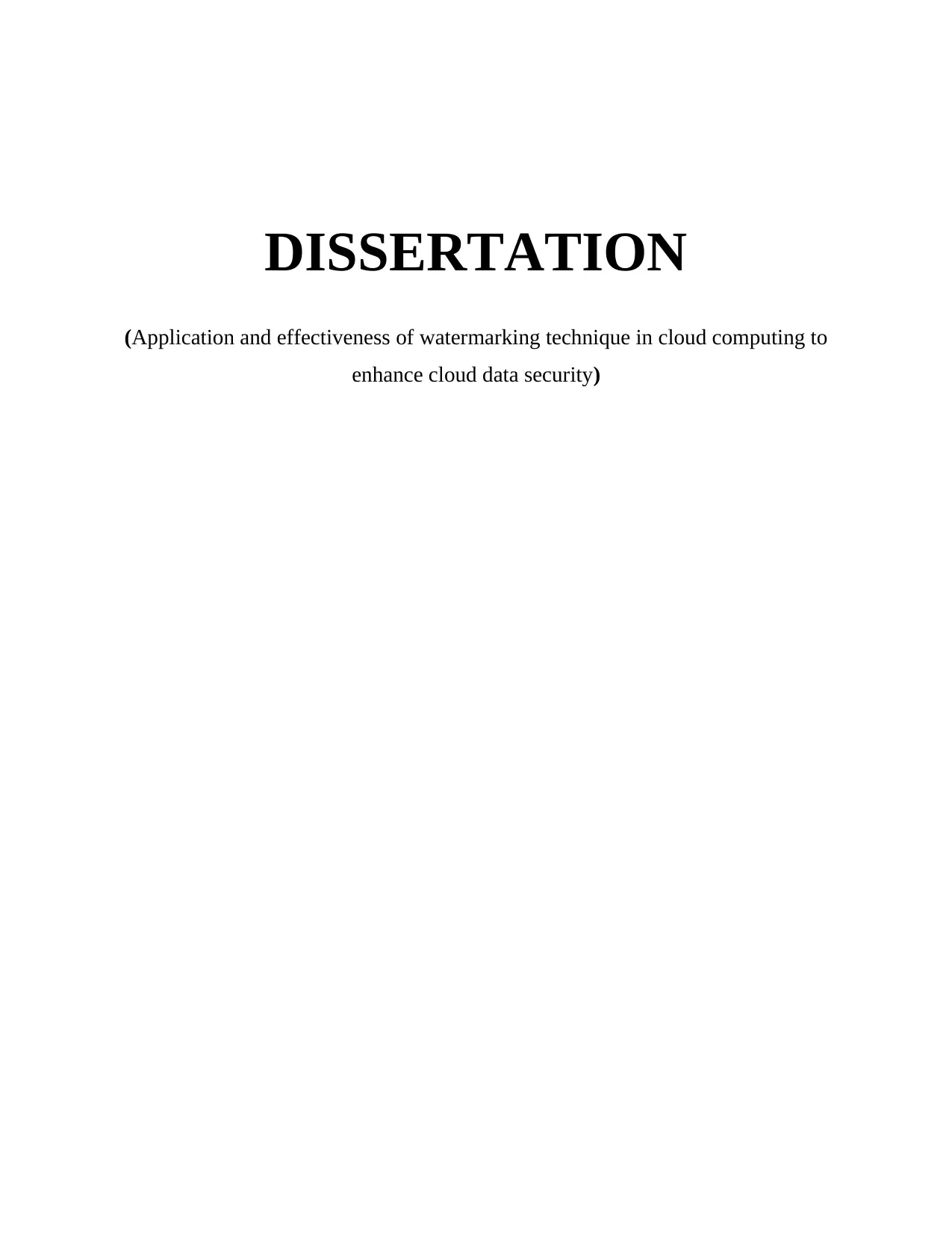
DISSERTATION
(Application and effectiveness of watermarking technique in cloud computing to
enhance cloud data security)
(Application and effectiveness of watermarking technique in cloud computing to
enhance cloud data security)
Paraphrase This Document
Need a fresh take? Get an instant paraphrase of this document with our AI Paraphraser
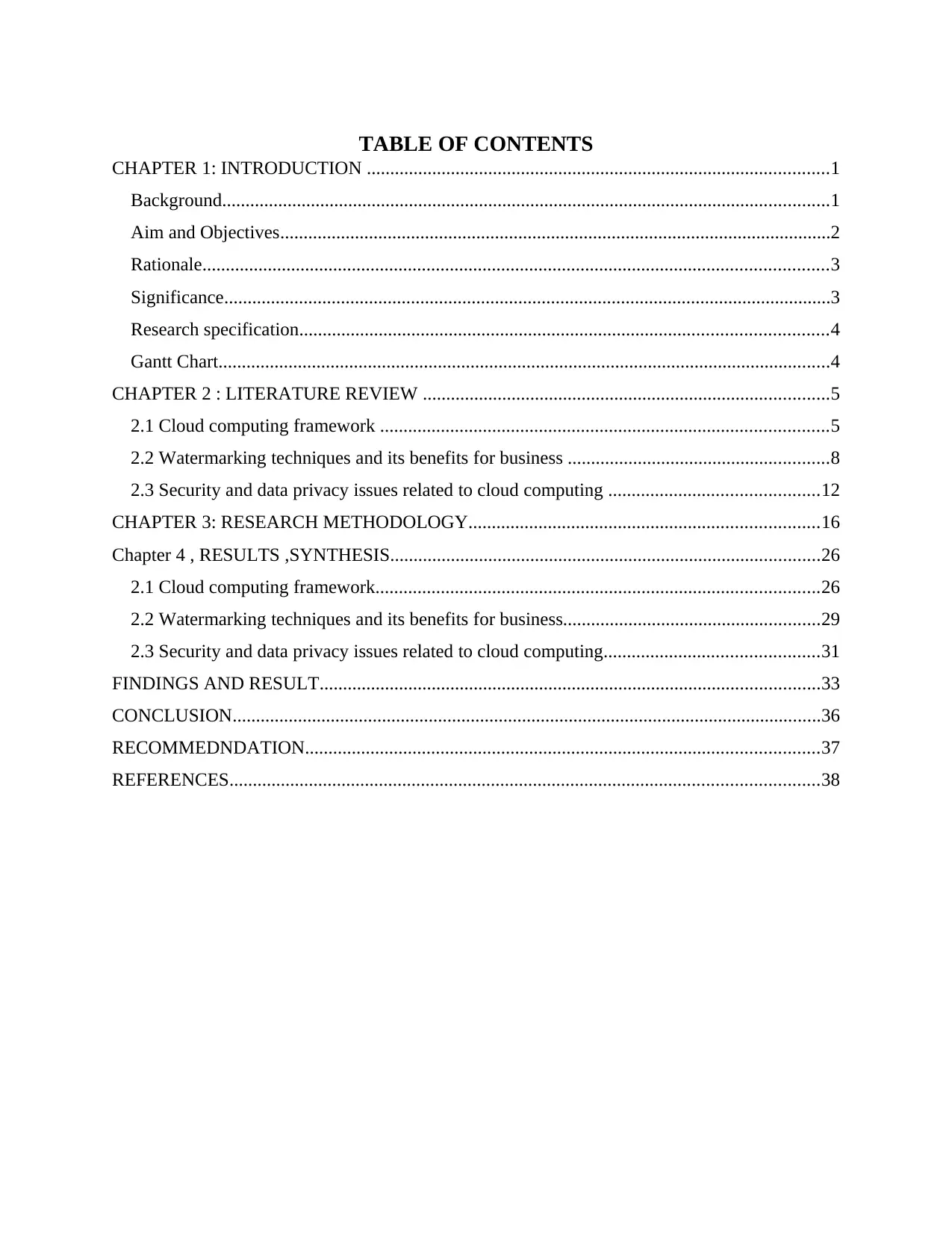
TABLE OF CONTENTS
CHAPTER 1: INTRODUCTION ...................................................................................................1
Background..................................................................................................................................1
Aim and Objectives......................................................................................................................2
Rationale......................................................................................................................................3
Significance..................................................................................................................................3
Research specification.................................................................................................................4
Gantt Chart...................................................................................................................................4
CHAPTER 2 : LITERATURE REVIEW .......................................................................................5
2.1 Cloud computing framework ................................................................................................5
2.2 Watermarking techniques and its benefits for business ........................................................8
2.3 Security and data privacy issues related to cloud computing .............................................12
CHAPTER 3: RESEARCH METHODOLOGY...........................................................................16
Chapter 4 , RESULTS ,SYNTHESIS............................................................................................26
2.1 Cloud computing framework...............................................................................................26
2.2 Watermarking techniques and its benefits for business.......................................................29
2.3 Security and data privacy issues related to cloud computing..............................................31
FINDINGS AND RESULT...........................................................................................................33
CONCLUSION..............................................................................................................................36
RECOMMEDNDATION..............................................................................................................37
REFERENCES..............................................................................................................................38
CHAPTER 1: INTRODUCTION ...................................................................................................1
Background..................................................................................................................................1
Aim and Objectives......................................................................................................................2
Rationale......................................................................................................................................3
Significance..................................................................................................................................3
Research specification.................................................................................................................4
Gantt Chart...................................................................................................................................4
CHAPTER 2 : LITERATURE REVIEW .......................................................................................5
2.1 Cloud computing framework ................................................................................................5
2.2 Watermarking techniques and its benefits for business ........................................................8
2.3 Security and data privacy issues related to cloud computing .............................................12
CHAPTER 3: RESEARCH METHODOLOGY...........................................................................16
Chapter 4 , RESULTS ,SYNTHESIS............................................................................................26
2.1 Cloud computing framework...............................................................................................26
2.2 Watermarking techniques and its benefits for business.......................................................29
2.3 Security and data privacy issues related to cloud computing..............................................31
FINDINGS AND RESULT...........................................................................................................33
CONCLUSION..............................................................................................................................36
RECOMMEDNDATION..............................................................................................................37
REFERENCES..............................................................................................................................38
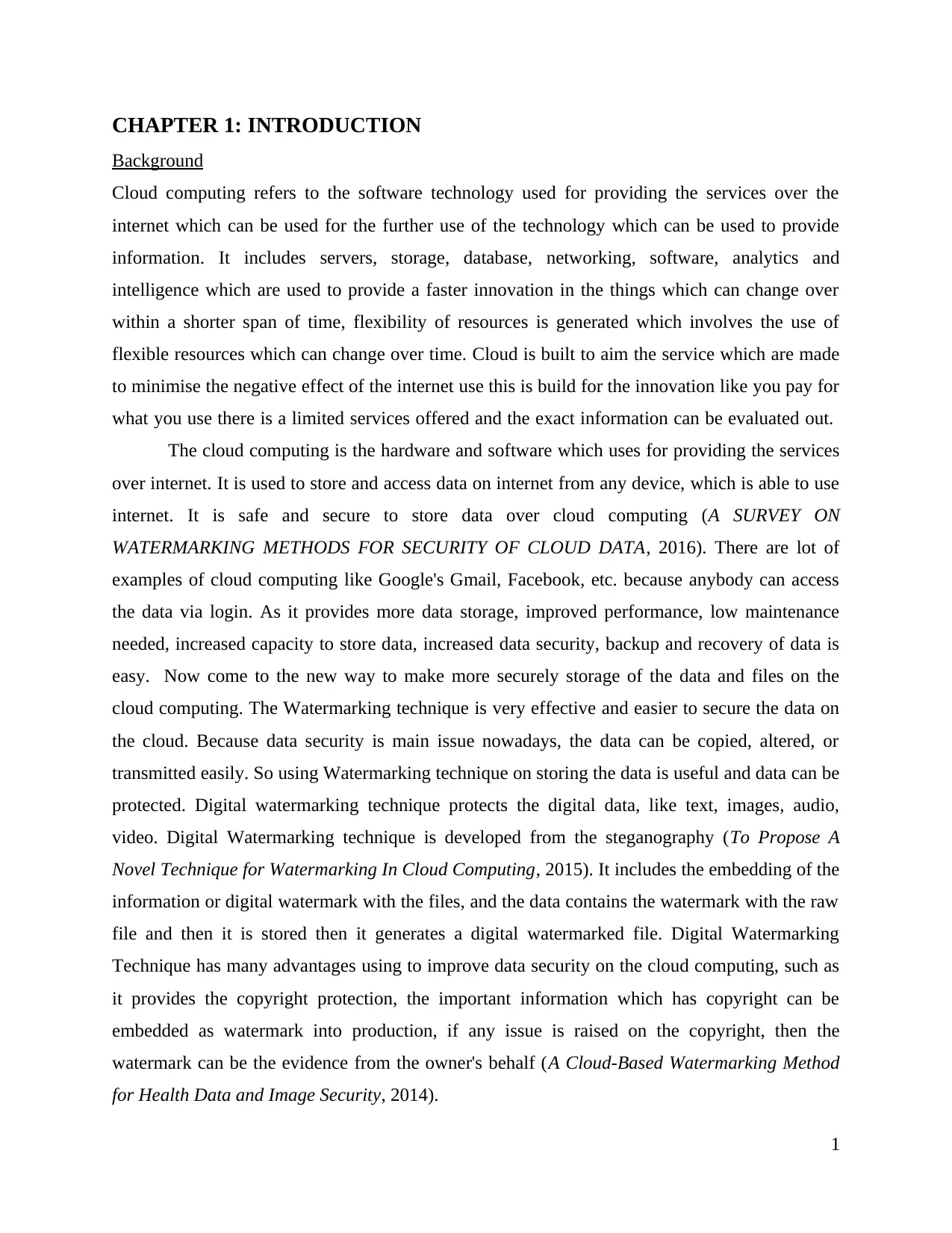
CHAPTER 1: INTRODUCTION
Background
Cloud computing refers to the software technology used for providing the services over the
internet which can be used for the further use of the technology which can be used to provide
information. It includes servers, storage, database, networking, software, analytics and
intelligence which are used to provide a faster innovation in the things which can change over
within a shorter span of time, flexibility of resources is generated which involves the use of
flexible resources which can change over time. Cloud is built to aim the service which are made
to minimise the negative effect of the internet use this is build for the innovation like you pay for
what you use there is a limited services offered and the exact information can be evaluated out.
The cloud computing is the hardware and software which uses for providing the services
over internet. It is used to store and access data on internet from any device, which is able to use
internet. It is safe and secure to store data over cloud computing (A SURVEY ON
WATERMARKING METHODS FOR SECURITY OF CLOUD DATA, 2016). There are lot of
examples of cloud computing like Google's Gmail, Facebook, etc. because anybody can access
the data via login. As it provides more data storage, improved performance, low maintenance
needed, increased capacity to store data, increased data security, backup and recovery of data is
easy. Now come to the new way to make more securely storage of the data and files on the
cloud computing. The Watermarking technique is very effective and easier to secure the data on
the cloud. Because data security is main issue nowadays, the data can be copied, altered, or
transmitted easily. So using Watermarking technique on storing the data is useful and data can be
protected. Digital watermarking technique protects the digital data, like text, images, audio,
video. Digital Watermarking technique is developed from the steganography (To Propose A
Novel Technique for Watermarking In Cloud Computing, 2015). It includes the embedding of the
information or digital watermark with the files, and the data contains the watermark with the raw
file and then it is stored then it generates a digital watermarked file. Digital Watermarking
Technique has many advantages using to improve data security on the cloud computing, such as
it provides the copyright protection, the important information which has copyright can be
embedded as watermark into production, if any issue is raised on the copyright, then the
watermark can be the evidence from the owner's behalf (A Cloud-Based Watermarking Method
for Health Data and Image Security, 2014).
1
Background
Cloud computing refers to the software technology used for providing the services over the
internet which can be used for the further use of the technology which can be used to provide
information. It includes servers, storage, database, networking, software, analytics and
intelligence which are used to provide a faster innovation in the things which can change over
within a shorter span of time, flexibility of resources is generated which involves the use of
flexible resources which can change over time. Cloud is built to aim the service which are made
to minimise the negative effect of the internet use this is build for the innovation like you pay for
what you use there is a limited services offered and the exact information can be evaluated out.
The cloud computing is the hardware and software which uses for providing the services
over internet. It is used to store and access data on internet from any device, which is able to use
internet. It is safe and secure to store data over cloud computing (A SURVEY ON
WATERMARKING METHODS FOR SECURITY OF CLOUD DATA, 2016). There are lot of
examples of cloud computing like Google's Gmail, Facebook, etc. because anybody can access
the data via login. As it provides more data storage, improved performance, low maintenance
needed, increased capacity to store data, increased data security, backup and recovery of data is
easy. Now come to the new way to make more securely storage of the data and files on the
cloud computing. The Watermarking technique is very effective and easier to secure the data on
the cloud. Because data security is main issue nowadays, the data can be copied, altered, or
transmitted easily. So using Watermarking technique on storing the data is useful and data can be
protected. Digital watermarking technique protects the digital data, like text, images, audio,
video. Digital Watermarking technique is developed from the steganography (To Propose A
Novel Technique for Watermarking In Cloud Computing, 2015). It includes the embedding of the
information or digital watermark with the files, and the data contains the watermark with the raw
file and then it is stored then it generates a digital watermarked file. Digital Watermarking
Technique has many advantages using to improve data security on the cloud computing, such as
it provides the copyright protection, the important information which has copyright can be
embedded as watermark into production, if any issue is raised on the copyright, then the
watermark can be the evidence from the owner's behalf (A Cloud-Based Watermarking Method
for Health Data and Image Security, 2014).
1
⊘ This is a preview!⊘
Do you want full access?
Subscribe today to unlock all pages.

Trusted by 1+ million students worldwide
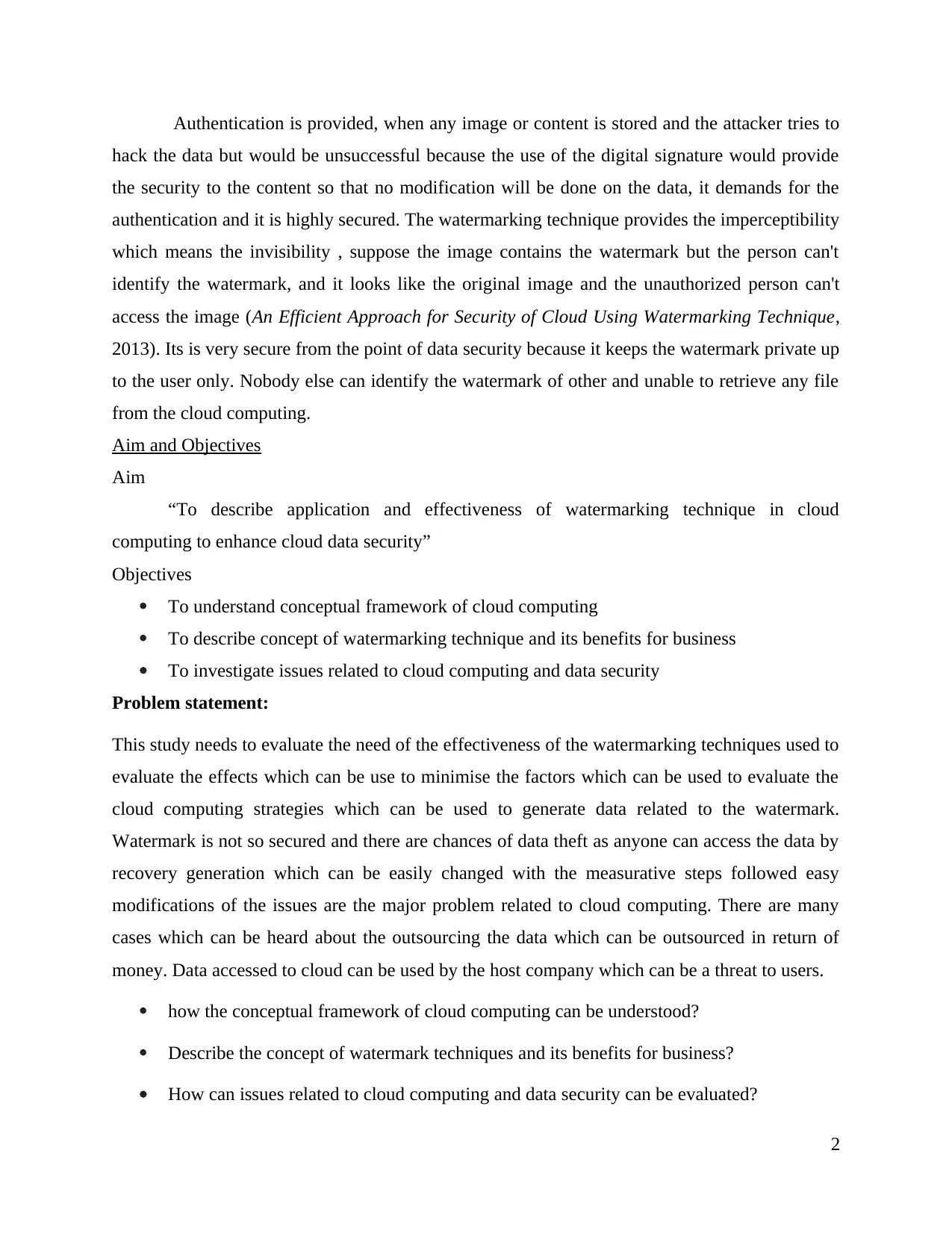
Authentication is provided, when any image or content is stored and the attacker tries to
hack the data but would be unsuccessful because the use of the digital signature would provide
the security to the content so that no modification will be done on the data, it demands for the
authentication and it is highly secured. The watermarking technique provides the imperceptibility
which means the invisibility , suppose the image contains the watermark but the person can't
identify the watermark, and it looks like the original image and the unauthorized person can't
access the image (An Efficient Approach for Security of Cloud Using Watermarking Technique,
2013). Its is very secure from the point of data security because it keeps the watermark private up
to the user only. Nobody else can identify the watermark of other and unable to retrieve any file
from the cloud computing.
Aim and Objectives
Aim
“To describe application and effectiveness of watermarking technique in cloud
computing to enhance cloud data security”
Objectives
To understand conceptual framework of cloud computing
To describe concept of watermarking technique and its benefits for business
To investigate issues related to cloud computing and data security
Problem statement:
This study needs to evaluate the need of the effectiveness of the watermarking techniques used to
evaluate the effects which can be use to minimise the factors which can be used to evaluate the
cloud computing strategies which can be used to generate data related to the watermark.
Watermark is not so secured and there are chances of data theft as anyone can access the data by
recovery generation which can be easily changed with the measurative steps followed easy
modifications of the issues are the major problem related to cloud computing. There are many
cases which can be heard about the outsourcing the data which can be outsourced in return of
money. Data accessed to cloud can be used by the host company which can be a threat to users.
how the conceptual framework of cloud computing can be understood?
Describe the concept of watermark techniques and its benefits for business?
How can issues related to cloud computing and data security can be evaluated?
2
hack the data but would be unsuccessful because the use of the digital signature would provide
the security to the content so that no modification will be done on the data, it demands for the
authentication and it is highly secured. The watermarking technique provides the imperceptibility
which means the invisibility , suppose the image contains the watermark but the person can't
identify the watermark, and it looks like the original image and the unauthorized person can't
access the image (An Efficient Approach for Security of Cloud Using Watermarking Technique,
2013). Its is very secure from the point of data security because it keeps the watermark private up
to the user only. Nobody else can identify the watermark of other and unable to retrieve any file
from the cloud computing.
Aim and Objectives
Aim
“To describe application and effectiveness of watermarking technique in cloud
computing to enhance cloud data security”
Objectives
To understand conceptual framework of cloud computing
To describe concept of watermarking technique and its benefits for business
To investigate issues related to cloud computing and data security
Problem statement:
This study needs to evaluate the need of the effectiveness of the watermarking techniques used to
evaluate the effects which can be use to minimise the factors which can be used to evaluate the
cloud computing strategies which can be used to generate data related to the watermark.
Watermark is not so secured and there are chances of data theft as anyone can access the data by
recovery generation which can be easily changed with the measurative steps followed easy
modifications of the issues are the major problem related to cloud computing. There are many
cases which can be heard about the outsourcing the data which can be outsourced in return of
money. Data accessed to cloud can be used by the host company which can be a threat to users.
how the conceptual framework of cloud computing can be understood?
Describe the concept of watermark techniques and its benefits for business?
How can issues related to cloud computing and data security can be evaluated?
2
Paraphrase This Document
Need a fresh take? Get an instant paraphrase of this document with our AI Paraphraser
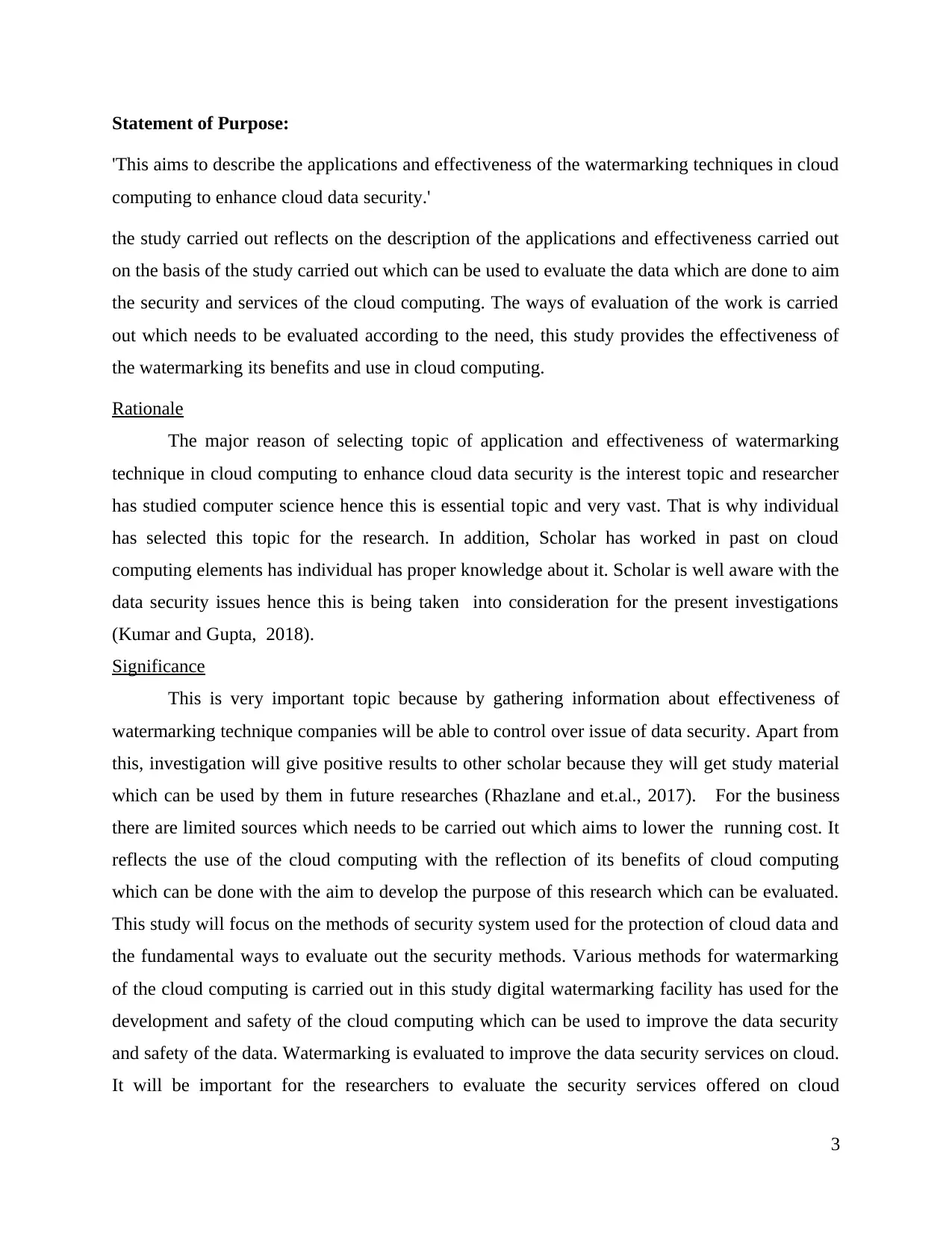
Statement of Purpose:
'This aims to describe the applications and effectiveness of the watermarking techniques in cloud
computing to enhance cloud data security.'
the study carried out reflects on the description of the applications and effectiveness carried out
on the basis of the study carried out which can be used to evaluate the data which are done to aim
the security and services of the cloud computing. The ways of evaluation of the work is carried
out which needs to be evaluated according to the need, this study provides the effectiveness of
the watermarking its benefits and use in cloud computing.
Rationale
The major reason of selecting topic of application and effectiveness of watermarking
technique in cloud computing to enhance cloud data security is the interest topic and researcher
has studied computer science hence this is essential topic and very vast. That is why individual
has selected this topic for the research. In addition, Scholar has worked in past on cloud
computing elements has individual has proper knowledge about it. Scholar is well aware with the
data security issues hence this is being taken into consideration for the present investigations
(Kumar and Gupta, 2018).
Significance
This is very important topic because by gathering information about effectiveness of
watermarking technique companies will be able to control over issue of data security. Apart from
this, investigation will give positive results to other scholar because they will get study material
which can be used by them in future researches (Rhazlane and et.al., 2017). For the business
there are limited sources which needs to be carried out which aims to lower the running cost. It
reflects the use of the cloud computing with the reflection of its benefits of cloud computing
which can be done with the aim to develop the purpose of this research which can be evaluated.
This study will focus on the methods of security system used for the protection of cloud data and
the fundamental ways to evaluate out the security methods. Various methods for watermarking
of the cloud computing is carried out in this study digital watermarking facility has used for the
development and safety of the cloud computing which can be used to improve the data security
and safety of the data. Watermarking is evaluated to improve the data security services on cloud.
It will be important for the researchers to evaluate the security services offered on cloud
3
'This aims to describe the applications and effectiveness of the watermarking techniques in cloud
computing to enhance cloud data security.'
the study carried out reflects on the description of the applications and effectiveness carried out
on the basis of the study carried out which can be used to evaluate the data which are done to aim
the security and services of the cloud computing. The ways of evaluation of the work is carried
out which needs to be evaluated according to the need, this study provides the effectiveness of
the watermarking its benefits and use in cloud computing.
Rationale
The major reason of selecting topic of application and effectiveness of watermarking
technique in cloud computing to enhance cloud data security is the interest topic and researcher
has studied computer science hence this is essential topic and very vast. That is why individual
has selected this topic for the research. In addition, Scholar has worked in past on cloud
computing elements has individual has proper knowledge about it. Scholar is well aware with the
data security issues hence this is being taken into consideration for the present investigations
(Kumar and Gupta, 2018).
Significance
This is very important topic because by gathering information about effectiveness of
watermarking technique companies will be able to control over issue of data security. Apart from
this, investigation will give positive results to other scholar because they will get study material
which can be used by them in future researches (Rhazlane and et.al., 2017). For the business
there are limited sources which needs to be carried out which aims to lower the running cost. It
reflects the use of the cloud computing with the reflection of its benefits of cloud computing
which can be done with the aim to develop the purpose of this research which can be evaluated.
This study will focus on the methods of security system used for the protection of cloud data and
the fundamental ways to evaluate out the security methods. Various methods for watermarking
of the cloud computing is carried out in this study digital watermarking facility has used for the
development and safety of the cloud computing which can be used to improve the data security
and safety of the data. Watermarking is evaluated to improve the data security services on cloud.
It will be important for the researchers to evaluate the security services offered on cloud
3
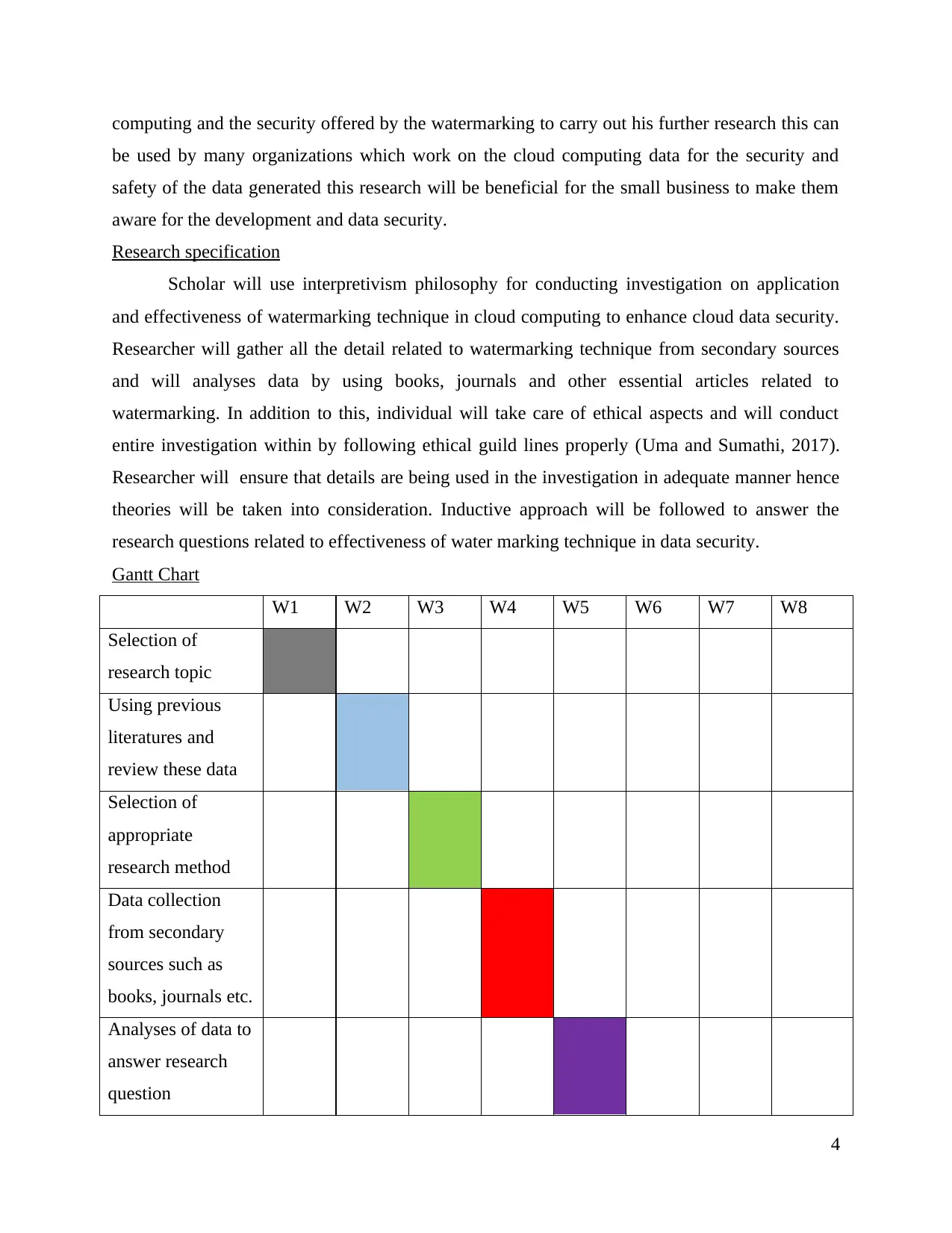
computing and the security offered by the watermarking to carry out his further research this can
be used by many organizations which work on the cloud computing data for the security and
safety of the data generated this research will be beneficial for the small business to make them
aware for the development and data security.
Research specification
Scholar will use interpretivism philosophy for conducting investigation on application
and effectiveness of watermarking technique in cloud computing to enhance cloud data security.
Researcher will gather all the detail related to watermarking technique from secondary sources
and will analyses data by using books, journals and other essential articles related to
watermarking. In addition to this, individual will take care of ethical aspects and will conduct
entire investigation within by following ethical guild lines properly (Uma and Sumathi, 2017).
Researcher will ensure that details are being used in the investigation in adequate manner hence
theories will be taken into consideration. Inductive approach will be followed to answer the
research questions related to effectiveness of water marking technique in data security.
Gantt Chart
W1 W2 W3 W4 W5 W6 W7 W8
Selection of
research topic
Using previous
literatures and
review these data
Selection of
appropriate
research method
Data collection
from secondary
sources such as
books, journals etc.
Analyses of data to
answer research
question
4
be used by many organizations which work on the cloud computing data for the security and
safety of the data generated this research will be beneficial for the small business to make them
aware for the development and data security.
Research specification
Scholar will use interpretivism philosophy for conducting investigation on application
and effectiveness of watermarking technique in cloud computing to enhance cloud data security.
Researcher will gather all the detail related to watermarking technique from secondary sources
and will analyses data by using books, journals and other essential articles related to
watermarking. In addition to this, individual will take care of ethical aspects and will conduct
entire investigation within by following ethical guild lines properly (Uma and Sumathi, 2017).
Researcher will ensure that details are being used in the investigation in adequate manner hence
theories will be taken into consideration. Inductive approach will be followed to answer the
research questions related to effectiveness of water marking technique in data security.
Gantt Chart
W1 W2 W3 W4 W5 W6 W7 W8
Selection of
research topic
Using previous
literatures and
review these data
Selection of
appropriate
research method
Data collection
from secondary
sources such as
books, journals etc.
Analyses of data to
answer research
question
4
⊘ This is a preview!⊘
Do you want full access?
Subscribe today to unlock all pages.

Trusted by 1+ million students worldwide
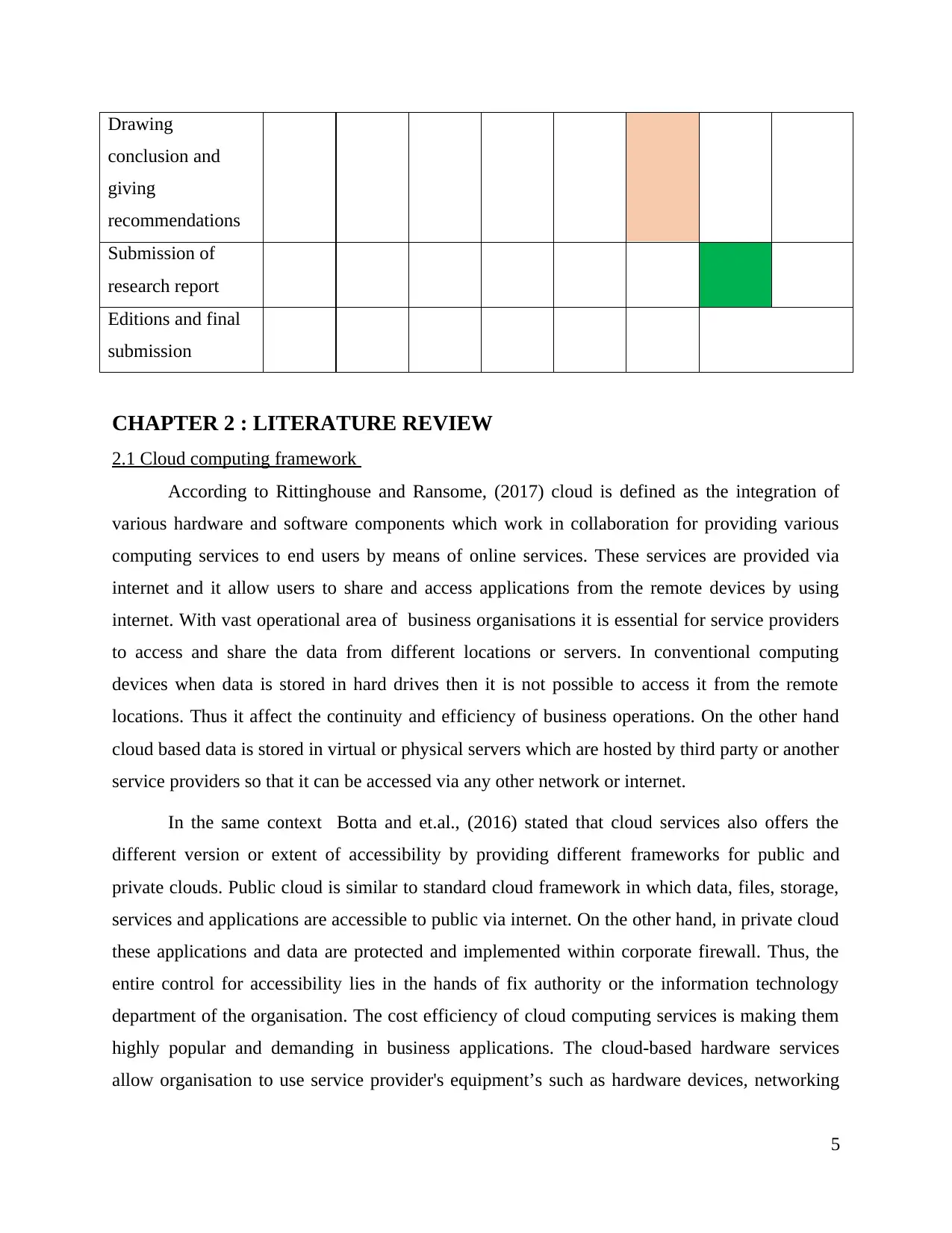
Drawing
conclusion and
giving
recommendations
Submission of
research report
Editions and final
submission
CHAPTER 2 : LITERATURE REVIEW
2.1 Cloud computing framework
According to Rittinghouse and Ransome, (2017) cloud is defined as the integration of
various hardware and software components which work in collaboration for providing various
computing services to end users by means of online services. These services are provided via
internet and it allow users to share and access applications from the remote devices by using
internet. With vast operational area of business organisations it is essential for service providers
to access and share the data from different locations or servers. In conventional computing
devices when data is stored in hard drives then it is not possible to access it from the remote
locations. Thus it affect the continuity and efficiency of business operations. On the other hand
cloud based data is stored in virtual or physical servers which are hosted by third party or another
service providers so that it can be accessed via any other network or internet.
In the same context Botta and et.al., (2016) stated that cloud services also offers the
different version or extent of accessibility by providing different frameworks for public and
private clouds. Public cloud is similar to standard cloud framework in which data, files, storage,
services and applications are accessible to public via internet. On the other hand, in private cloud
these applications and data are protected and implemented within corporate firewall. Thus, the
entire control for accessibility lies in the hands of fix authority or the information technology
department of the organisation. The cost efficiency of cloud computing services is making them
highly popular and demanding in business applications. The cloud-based hardware services
allow organisation to use service provider's equipment’s such as hardware devices, networking
5
conclusion and
giving
recommendations
Submission of
research report
Editions and final
submission
CHAPTER 2 : LITERATURE REVIEW
2.1 Cloud computing framework
According to Rittinghouse and Ransome, (2017) cloud is defined as the integration of
various hardware and software components which work in collaboration for providing various
computing services to end users by means of online services. These services are provided via
internet and it allow users to share and access applications from the remote devices by using
internet. With vast operational area of business organisations it is essential for service providers
to access and share the data from different locations or servers. In conventional computing
devices when data is stored in hard drives then it is not possible to access it from the remote
locations. Thus it affect the continuity and efficiency of business operations. On the other hand
cloud based data is stored in virtual or physical servers which are hosted by third party or another
service providers so that it can be accessed via any other network or internet.
In the same context Botta and et.al., (2016) stated that cloud services also offers the
different version or extent of accessibility by providing different frameworks for public and
private clouds. Public cloud is similar to standard cloud framework in which data, files, storage,
services and applications are accessible to public via internet. On the other hand, in private cloud
these applications and data are protected and implemented within corporate firewall. Thus, the
entire control for accessibility lies in the hands of fix authority or the information technology
department of the organisation. The cost efficiency of cloud computing services is making them
highly popular and demanding in business applications. The cloud-based hardware services
allow organisation to use service provider's equipment’s such as hardware devices, networking
5
Paraphrase This Document
Need a fresh take? Get an instant paraphrase of this document with our AI Paraphraser
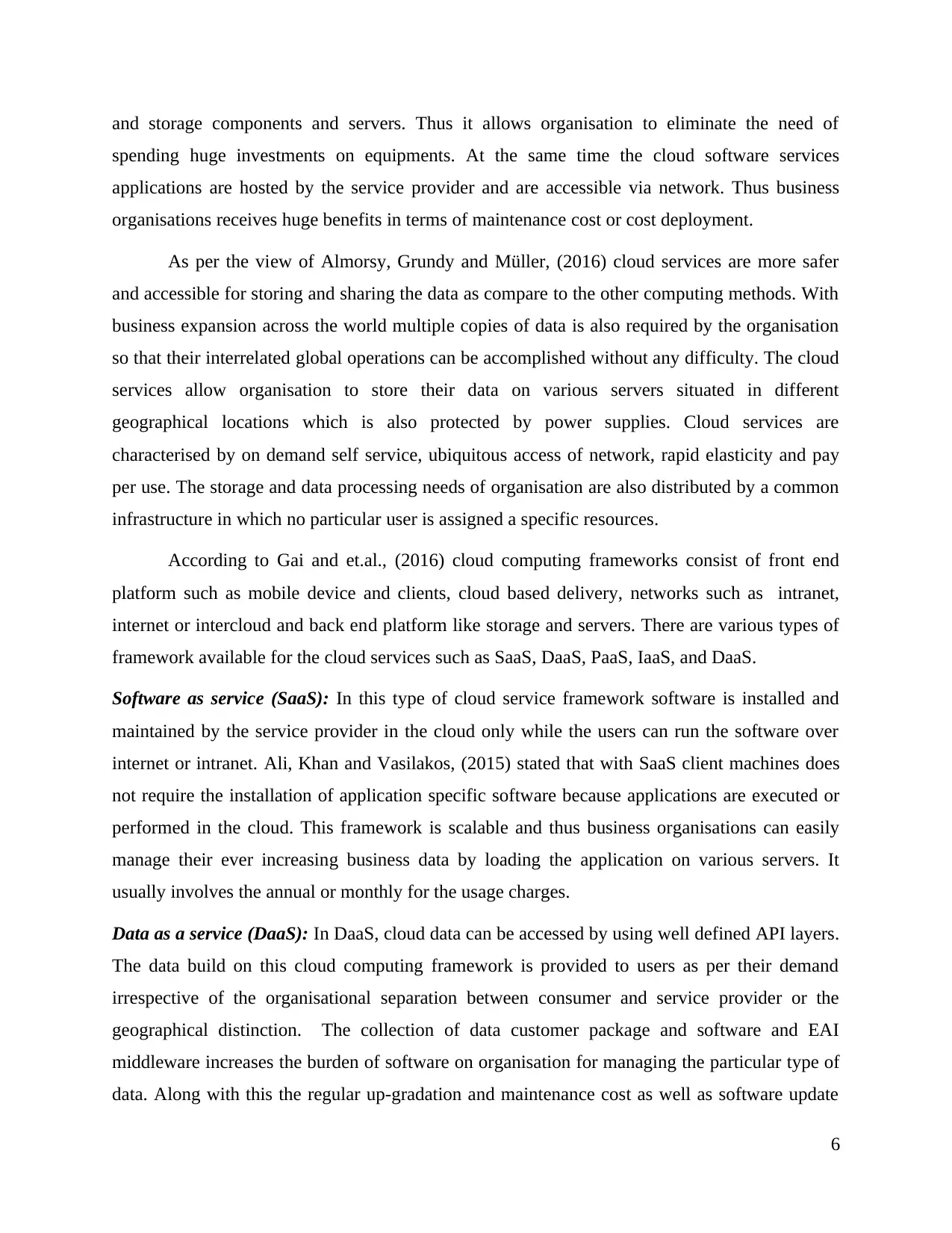
and storage components and servers. Thus it allows organisation to eliminate the need of
spending huge investments on equipments. At the same time the cloud software services
applications are hosted by the service provider and are accessible via network. Thus business
organisations receives huge benefits in terms of maintenance cost or cost deployment.
As per the view of Almorsy, Grundy and Müller, (2016) cloud services are more safer
and accessible for storing and sharing the data as compare to the other computing methods. With
business expansion across the world multiple copies of data is also required by the organisation
so that their interrelated global operations can be accomplished without any difficulty. The cloud
services allow organisation to store their data on various servers situated in different
geographical locations which is also protected by power supplies. Cloud services are
characterised by on demand self service, ubiquitous access of network, rapid elasticity and pay
per use. The storage and data processing needs of organisation are also distributed by a common
infrastructure in which no particular user is assigned a specific resources.
According to Gai and et.al., (2016) cloud computing frameworks consist of front end
platform such as mobile device and clients, cloud based delivery, networks such as intranet,
internet or intercloud and back end platform like storage and servers. There are various types of
framework available for the cloud services such as SaaS, DaaS, PaaS, IaaS, and DaaS.
Software as service (SaaS): In this type of cloud service framework software is installed and
maintained by the service provider in the cloud only while the users can run the software over
internet or intranet. Ali, Khan and Vasilakos, (2015) stated that with SaaS client machines does
not require the installation of application specific software because applications are executed or
performed in the cloud. This framework is scalable and thus business organisations can easily
manage their ever increasing business data by loading the application on various servers. It
usually involves the annual or monthly for the usage charges.
Data as a service (DaaS): In DaaS, cloud data can be accessed by using well defined API layers.
The data build on this cloud computing framework is provided to users as per their demand
irrespective of the organisational separation between consumer and service provider or the
geographical distinction. The collection of data customer package and software and EAI
middleware increases the burden of software on organisation for managing the particular type of
data. Along with this the regular up-gradation and maintenance cost as well as software update
6
spending huge investments on equipments. At the same time the cloud software services
applications are hosted by the service provider and are accessible via network. Thus business
organisations receives huge benefits in terms of maintenance cost or cost deployment.
As per the view of Almorsy, Grundy and Müller, (2016) cloud services are more safer
and accessible for storing and sharing the data as compare to the other computing methods. With
business expansion across the world multiple copies of data is also required by the organisation
so that their interrelated global operations can be accomplished without any difficulty. The cloud
services allow organisation to store their data on various servers situated in different
geographical locations which is also protected by power supplies. Cloud services are
characterised by on demand self service, ubiquitous access of network, rapid elasticity and pay
per use. The storage and data processing needs of organisation are also distributed by a common
infrastructure in which no particular user is assigned a specific resources.
According to Gai and et.al., (2016) cloud computing frameworks consist of front end
platform such as mobile device and clients, cloud based delivery, networks such as intranet,
internet or intercloud and back end platform like storage and servers. There are various types of
framework available for the cloud services such as SaaS, DaaS, PaaS, IaaS, and DaaS.
Software as service (SaaS): In this type of cloud service framework software is installed and
maintained by the service provider in the cloud only while the users can run the software over
internet or intranet. Ali, Khan and Vasilakos, (2015) stated that with SaaS client machines does
not require the installation of application specific software because applications are executed or
performed in the cloud. This framework is scalable and thus business organisations can easily
manage their ever increasing business data by loading the application on various servers. It
usually involves the annual or monthly for the usage charges.
Data as a service (DaaS): In DaaS, cloud data can be accessed by using well defined API layers.
The data build on this cloud computing framework is provided to users as per their demand
irrespective of the organisational separation between consumer and service provider or the
geographical distinction. The collection of data customer package and software and EAI
middleware increases the burden of software on organisation for managing the particular type of
data. Along with this the regular up-gradation and maintenance cost as well as software update
6
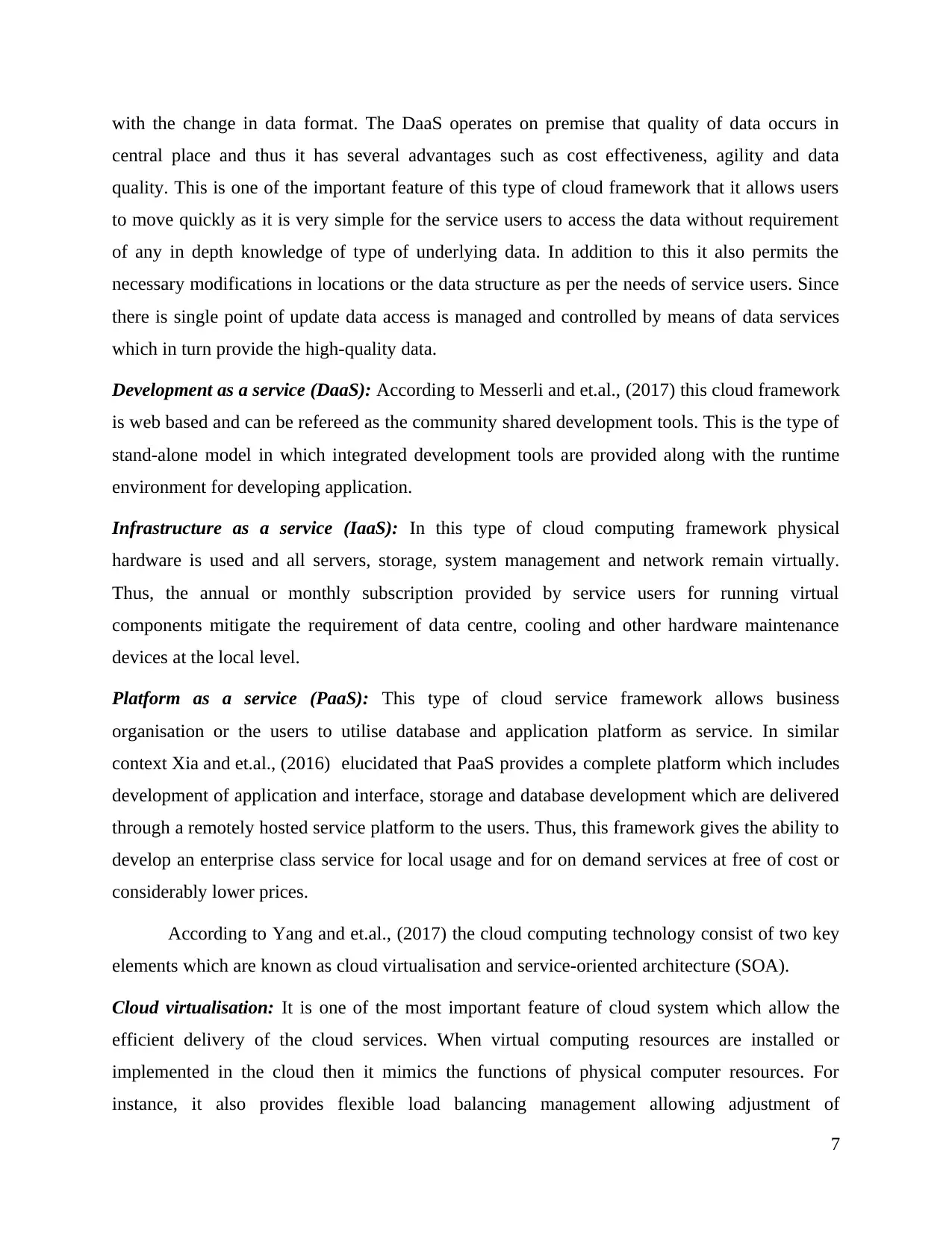
with the change in data format. The DaaS operates on premise that quality of data occurs in
central place and thus it has several advantages such as cost effectiveness, agility and data
quality. This is one of the important feature of this type of cloud framework that it allows users
to move quickly as it is very simple for the service users to access the data without requirement
of any in depth knowledge of type of underlying data. In addition to this it also permits the
necessary modifications in locations or the data structure as per the needs of service users. Since
there is single point of update data access is managed and controlled by means of data services
which in turn provide the high-quality data.
Development as a service (DaaS): According to Messerli and et.al., (2017) this cloud framework
is web based and can be refereed as the community shared development tools. This is the type of
stand-alone model in which integrated development tools are provided along with the runtime
environment for developing application.
Infrastructure as a service (IaaS): In this type of cloud computing framework physical
hardware is used and all servers, storage, system management and network remain virtually.
Thus, the annual or monthly subscription provided by service users for running virtual
components mitigate the requirement of data centre, cooling and other hardware maintenance
devices at the local level.
Platform as a service (PaaS): This type of cloud service framework allows business
organisation or the users to utilise database and application platform as service. In similar
context Xia and et.al., (2016) elucidated that PaaS provides a complete platform which includes
development of application and interface, storage and database development which are delivered
through a remotely hosted service platform to the users. Thus, this framework gives the ability to
develop an enterprise class service for local usage and for on demand services at free of cost or
considerably lower prices.
According to Yang and et.al., (2017) the cloud computing technology consist of two key
elements which are known as cloud virtualisation and service-oriented architecture (SOA).
Cloud virtualisation: It is one of the most important feature of cloud system which allow the
efficient delivery of the cloud services. When virtual computing resources are installed or
implemented in the cloud then it mimics the functions of physical computer resources. For
instance, it also provides flexible load balancing management allowing adjustment of
7
central place and thus it has several advantages such as cost effectiveness, agility and data
quality. This is one of the important feature of this type of cloud framework that it allows users
to move quickly as it is very simple for the service users to access the data without requirement
of any in depth knowledge of type of underlying data. In addition to this it also permits the
necessary modifications in locations or the data structure as per the needs of service users. Since
there is single point of update data access is managed and controlled by means of data services
which in turn provide the high-quality data.
Development as a service (DaaS): According to Messerli and et.al., (2017) this cloud framework
is web based and can be refereed as the community shared development tools. This is the type of
stand-alone model in which integrated development tools are provided along with the runtime
environment for developing application.
Infrastructure as a service (IaaS): In this type of cloud computing framework physical
hardware is used and all servers, storage, system management and network remain virtually.
Thus, the annual or monthly subscription provided by service users for running virtual
components mitigate the requirement of data centre, cooling and other hardware maintenance
devices at the local level.
Platform as a service (PaaS): This type of cloud service framework allows business
organisation or the users to utilise database and application platform as service. In similar
context Xia and et.al., (2016) elucidated that PaaS provides a complete platform which includes
development of application and interface, storage and database development which are delivered
through a remotely hosted service platform to the users. Thus, this framework gives the ability to
develop an enterprise class service for local usage and for on demand services at free of cost or
considerably lower prices.
According to Yang and et.al., (2017) the cloud computing technology consist of two key
elements which are known as cloud virtualisation and service-oriented architecture (SOA).
Cloud virtualisation: It is one of the most important feature of cloud system which allow the
efficient delivery of the cloud services. When virtual computing resources are installed or
implemented in the cloud then it mimics the functions of physical computer resources. For
instance, it also provides flexible load balancing management allowing adjustment of
7
⊘ This is a preview!⊘
Do you want full access?
Subscribe today to unlock all pages.

Trusted by 1+ million students worldwide
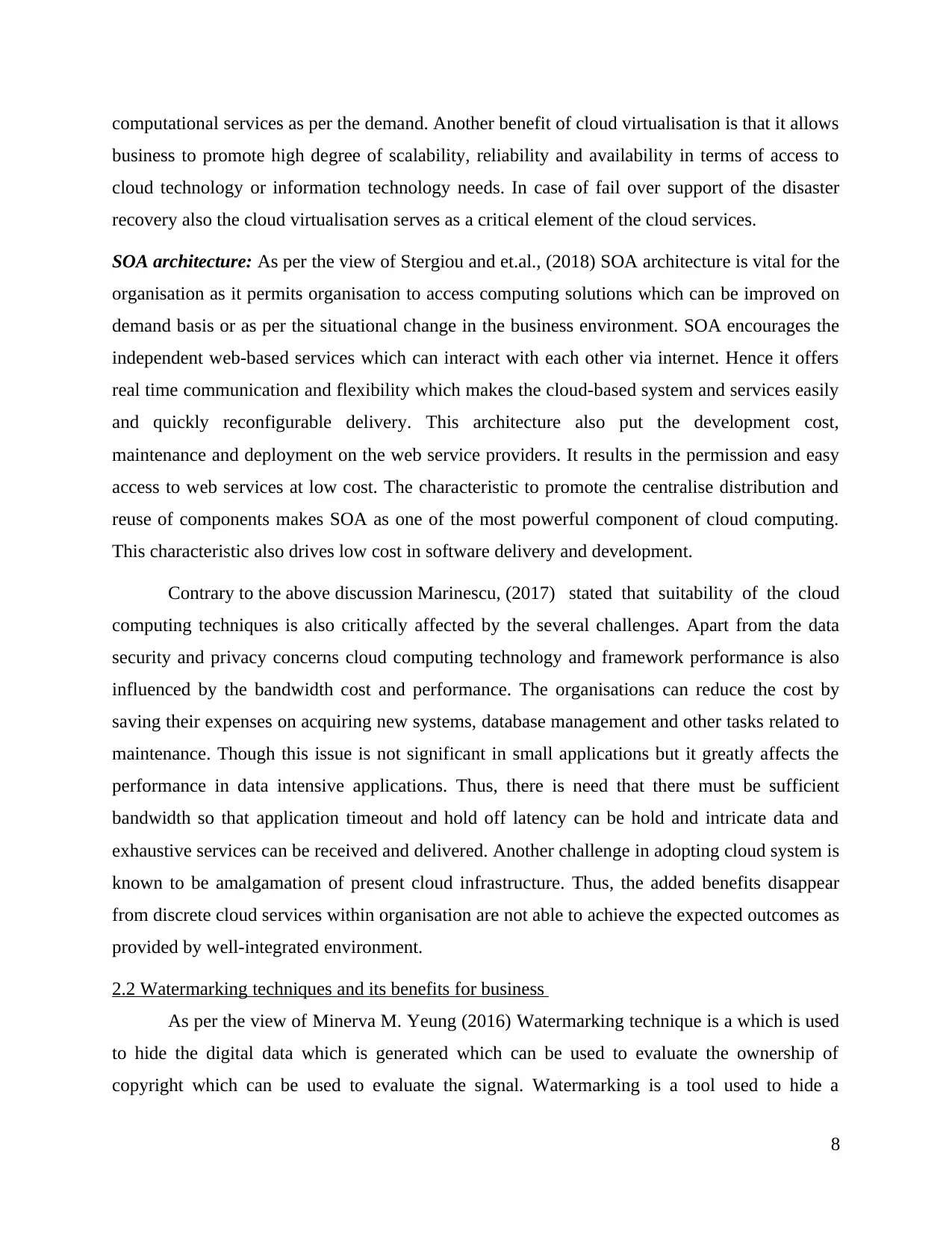
computational services as per the demand. Another benefit of cloud virtualisation is that it allows
business to promote high degree of scalability, reliability and availability in terms of access to
cloud technology or information technology needs. In case of fail over support of the disaster
recovery also the cloud virtualisation serves as a critical element of the cloud services.
SOA architecture: As per the view of Stergiou and et.al., (2018) SOA architecture is vital for the
organisation as it permits organisation to access computing solutions which can be improved on
demand basis or as per the situational change in the business environment. SOA encourages the
independent web-based services which can interact with each other via internet. Hence it offers
real time communication and flexibility which makes the cloud-based system and services easily
and quickly reconfigurable delivery. This architecture also put the development cost,
maintenance and deployment on the web service providers. It results in the permission and easy
access to web services at low cost. The characteristic to promote the centralise distribution and
reuse of components makes SOA as one of the most powerful component of cloud computing.
This characteristic also drives low cost in software delivery and development.
Contrary to the above discussion Marinescu, (2017) stated that suitability of the cloud
computing techniques is also critically affected by the several challenges. Apart from the data
security and privacy concerns cloud computing technology and framework performance is also
influenced by the bandwidth cost and performance. The organisations can reduce the cost by
saving their expenses on acquiring new systems, database management and other tasks related to
maintenance. Though this issue is not significant in small applications but it greatly affects the
performance in data intensive applications. Thus, there is need that there must be sufficient
bandwidth so that application timeout and hold off latency can be hold and intricate data and
exhaustive services can be received and delivered. Another challenge in adopting cloud system is
known to be amalgamation of present cloud infrastructure. Thus, the added benefits disappear
from discrete cloud services within organisation are not able to achieve the expected outcomes as
provided by well-integrated environment.
2.2 Watermarking techniques and its benefits for business
As per the view of Minerva M. Yeung (2016) Watermarking technique is a which is used
to hide the digital data which is generated which can be used to evaluate the ownership of
copyright which can be used to evaluate the signal. Watermarking is a tool used to hide a
8
business to promote high degree of scalability, reliability and availability in terms of access to
cloud technology or information technology needs. In case of fail over support of the disaster
recovery also the cloud virtualisation serves as a critical element of the cloud services.
SOA architecture: As per the view of Stergiou and et.al., (2018) SOA architecture is vital for the
organisation as it permits organisation to access computing solutions which can be improved on
demand basis or as per the situational change in the business environment. SOA encourages the
independent web-based services which can interact with each other via internet. Hence it offers
real time communication and flexibility which makes the cloud-based system and services easily
and quickly reconfigurable delivery. This architecture also put the development cost,
maintenance and deployment on the web service providers. It results in the permission and easy
access to web services at low cost. The characteristic to promote the centralise distribution and
reuse of components makes SOA as one of the most powerful component of cloud computing.
This characteristic also drives low cost in software delivery and development.
Contrary to the above discussion Marinescu, (2017) stated that suitability of the cloud
computing techniques is also critically affected by the several challenges. Apart from the data
security and privacy concerns cloud computing technology and framework performance is also
influenced by the bandwidth cost and performance. The organisations can reduce the cost by
saving their expenses on acquiring new systems, database management and other tasks related to
maintenance. Though this issue is not significant in small applications but it greatly affects the
performance in data intensive applications. Thus, there is need that there must be sufficient
bandwidth so that application timeout and hold off latency can be hold and intricate data and
exhaustive services can be received and delivered. Another challenge in adopting cloud system is
known to be amalgamation of present cloud infrastructure. Thus, the added benefits disappear
from discrete cloud services within organisation are not able to achieve the expected outcomes as
provided by well-integrated environment.
2.2 Watermarking techniques and its benefits for business
As per the view of Minerva M. Yeung (2016) Watermarking technique is a which is used
to hide the digital data which is generated which can be used to evaluate the ownership of
copyright which can be used to evaluate the signal. Watermarking is a tool used to hide a
8
Paraphrase This Document
Need a fresh take? Get an instant paraphrase of this document with our AI Paraphraser
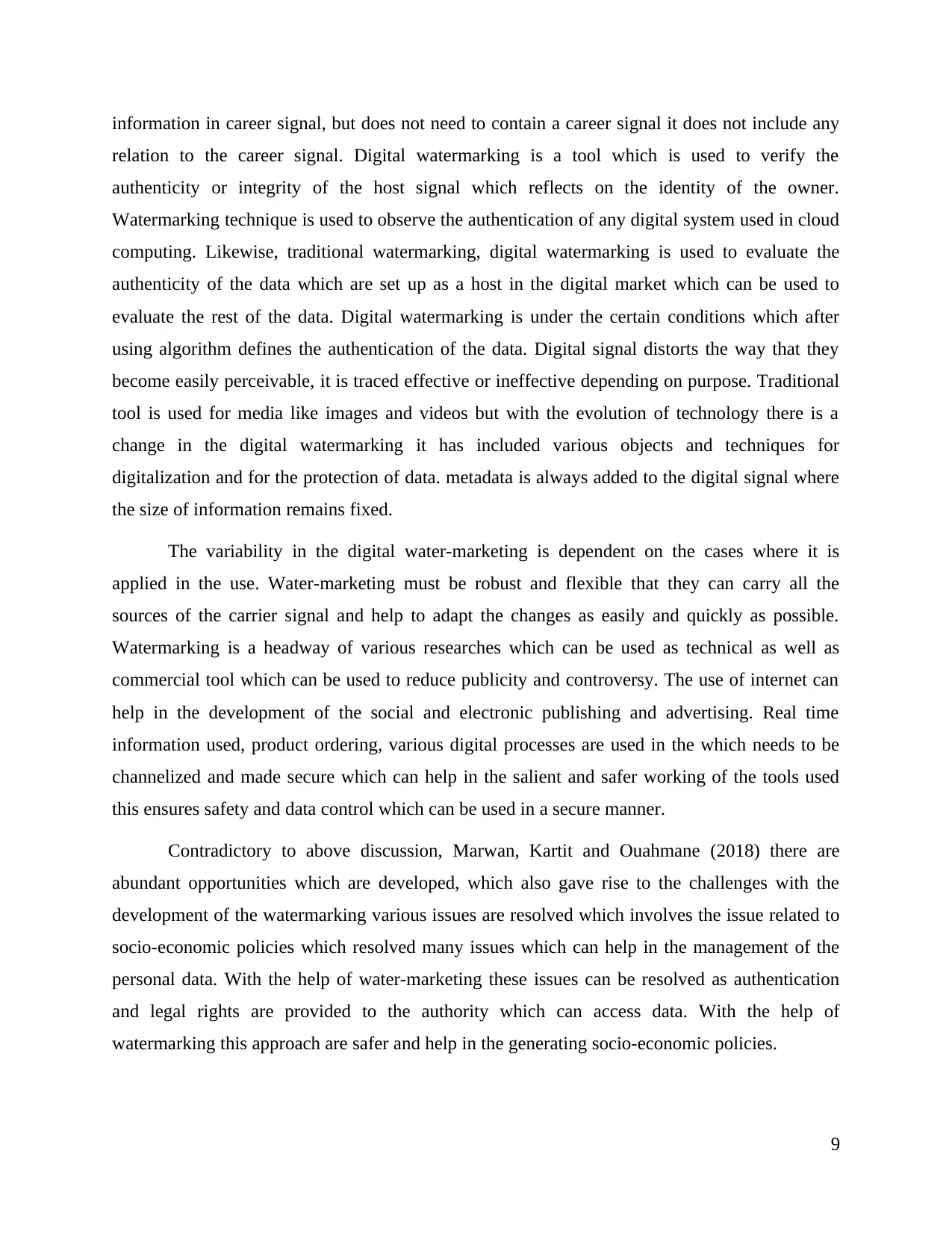
information in career signal, but does not need to contain a career signal it does not include any
relation to the career signal. Digital watermarking is a tool which is used to verify the
authenticity or integrity of the host signal which reflects on the identity of the owner.
Watermarking technique is used to observe the authentication of any digital system used in cloud
computing. Likewise, traditional watermarking, digital watermarking is used to evaluate the
authenticity of the data which are set up as a host in the digital market which can be used to
evaluate the rest of the data. Digital watermarking is under the certain conditions which after
using algorithm defines the authentication of the data. Digital signal distorts the way that they
become easily perceivable, it is traced effective or ineffective depending on purpose. Traditional
tool is used for media like images and videos but with the evolution of technology there is a
change in the digital watermarking it has included various objects and techniques for
digitalization and for the protection of data. metadata is always added to the digital signal where
the size of information remains fixed.
The variability in the digital water-marketing is dependent on the cases where it is
applied in the use. Water-marketing must be robust and flexible that they can carry all the
sources of the carrier signal and help to adapt the changes as easily and quickly as possible.
Watermarking is a headway of various researches which can be used as technical as well as
commercial tool which can be used to reduce publicity and controversy. The use of internet can
help in the development of the social and electronic publishing and advertising. Real time
information used, product ordering, various digital processes are used in the which needs to be
channelized and made secure which can help in the salient and safer working of the tools used
this ensures safety and data control which can be used in a secure manner.
Contradictory to above discussion, Marwan, Kartit and Ouahmane (2018) there are
abundant opportunities which are developed, which also gave rise to the challenges with the
development of the watermarking various issues are resolved which involves the issue related to
socio-economic policies which resolved many issues which can help in the management of the
personal data. With the help of water-marketing these issues can be resolved as authentication
and legal rights are provided to the authority which can access data. With the help of
watermarking this approach are safer and help in the generating socio-economic policies.
9
relation to the career signal. Digital watermarking is a tool which is used to verify the
authenticity or integrity of the host signal which reflects on the identity of the owner.
Watermarking technique is used to observe the authentication of any digital system used in cloud
computing. Likewise, traditional watermarking, digital watermarking is used to evaluate the
authenticity of the data which are set up as a host in the digital market which can be used to
evaluate the rest of the data. Digital watermarking is under the certain conditions which after
using algorithm defines the authentication of the data. Digital signal distorts the way that they
become easily perceivable, it is traced effective or ineffective depending on purpose. Traditional
tool is used for media like images and videos but with the evolution of technology there is a
change in the digital watermarking it has included various objects and techniques for
digitalization and for the protection of data. metadata is always added to the digital signal where
the size of information remains fixed.
The variability in the digital water-marketing is dependent on the cases where it is
applied in the use. Water-marketing must be robust and flexible that they can carry all the
sources of the carrier signal and help to adapt the changes as easily and quickly as possible.
Watermarking is a headway of various researches which can be used as technical as well as
commercial tool which can be used to reduce publicity and controversy. The use of internet can
help in the development of the social and electronic publishing and advertising. Real time
information used, product ordering, various digital processes are used in the which needs to be
channelized and made secure which can help in the salient and safer working of the tools used
this ensures safety and data control which can be used in a secure manner.
Contradictory to above discussion, Marwan, Kartit and Ouahmane (2018) there are
abundant opportunities which are developed, which also gave rise to the challenges with the
development of the watermarking various issues are resolved which involves the issue related to
socio-economic policies which resolved many issues which can help in the management of the
personal data. With the help of water-marketing these issues can be resolved as authentication
and legal rights are provided to the authority which can access data. With the help of
watermarking this approach are safer and help in the generating socio-economic policies.
9
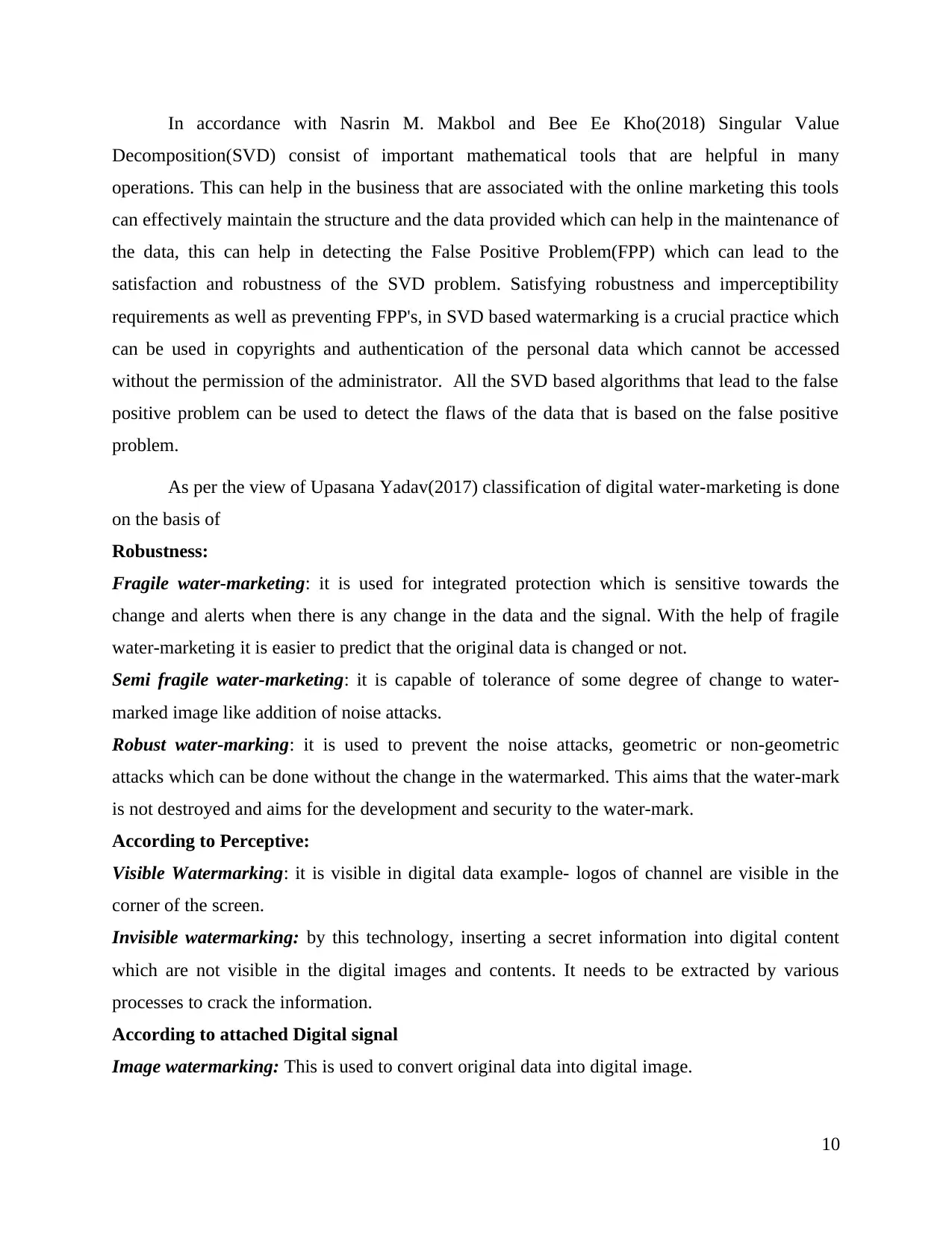
In accordance with Nasrin M. Makbol and Bee Ee Kho(2018) Singular Value
Decomposition(SVD) consist of important mathematical tools that are helpful in many
operations. This can help in the business that are associated with the online marketing this tools
can effectively maintain the structure and the data provided which can help in the maintenance of
the data, this can help in detecting the False Positive Problem(FPP) which can lead to the
satisfaction and robustness of the SVD problem. Satisfying robustness and imperceptibility
requirements as well as preventing FPP's, in SVD based watermarking is a crucial practice which
can be used in copyrights and authentication of the personal data which cannot be accessed
without the permission of the administrator. All the SVD based algorithms that lead to the false
positive problem can be used to detect the flaws of the data that is based on the false positive
problem.
As per the view of Upasana Yadav(2017) classification of digital water-marketing is done
on the basis of
Robustness:
Fragile water-marketing: it is used for integrated protection which is sensitive towards the
change and alerts when there is any change in the data and the signal. With the help of fragile
water-marketing it is easier to predict that the original data is changed or not.
Semi fragile water-marketing: it is capable of tolerance of some degree of change to water-
marked image like addition of noise attacks.
Robust water-marking: it is used to prevent the noise attacks, geometric or non-geometric
attacks which can be done without the change in the watermarked. This aims that the water-mark
is not destroyed and aims for the development and security to the water-mark.
According to Perceptive:
Visible Watermarking: it is visible in digital data example- logos of channel are visible in the
corner of the screen.
Invisible watermarking: by this technology, inserting a secret information into digital content
which are not visible in the digital images and contents. It needs to be extracted by various
processes to crack the information.
According to attached Digital signal
Image watermarking: This is used to convert original data into digital image.
10
Decomposition(SVD) consist of important mathematical tools that are helpful in many
operations. This can help in the business that are associated with the online marketing this tools
can effectively maintain the structure and the data provided which can help in the maintenance of
the data, this can help in detecting the False Positive Problem(FPP) which can lead to the
satisfaction and robustness of the SVD problem. Satisfying robustness and imperceptibility
requirements as well as preventing FPP's, in SVD based watermarking is a crucial practice which
can be used in copyrights and authentication of the personal data which cannot be accessed
without the permission of the administrator. All the SVD based algorithms that lead to the false
positive problem can be used to detect the flaws of the data that is based on the false positive
problem.
As per the view of Upasana Yadav(2017) classification of digital water-marketing is done
on the basis of
Robustness:
Fragile water-marketing: it is used for integrated protection which is sensitive towards the
change and alerts when there is any change in the data and the signal. With the help of fragile
water-marketing it is easier to predict that the original data is changed or not.
Semi fragile water-marketing: it is capable of tolerance of some degree of change to water-
marked image like addition of noise attacks.
Robust water-marking: it is used to prevent the noise attacks, geometric or non-geometric
attacks which can be done without the change in the watermarked. This aims that the water-mark
is not destroyed and aims for the development and security to the water-mark.
According to Perceptive:
Visible Watermarking: it is visible in digital data example- logos of channel are visible in the
corner of the screen.
Invisible watermarking: by this technology, inserting a secret information into digital content
which are not visible in the digital images and contents. It needs to be extracted by various
processes to crack the information.
According to attached Digital signal
Image watermarking: This is used to convert original data into digital image.
10
⊘ This is a preview!⊘
Do you want full access?
Subscribe today to unlock all pages.

Trusted by 1+ million students worldwide
1 out of 25
Related Documents
Your All-in-One AI-Powered Toolkit for Academic Success.
+13062052269
info@desklib.com
Available 24*7 on WhatsApp / Email
![[object Object]](/_next/static/media/star-bottom.7253800d.svg)
Unlock your academic potential
Copyright © 2020–2025 A2Z Services. All Rights Reserved. Developed and managed by ZUCOL.





